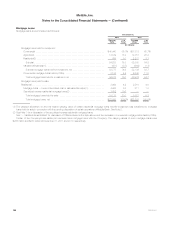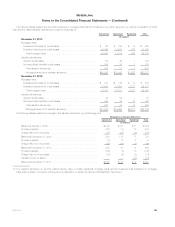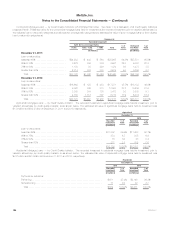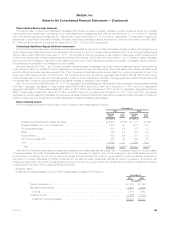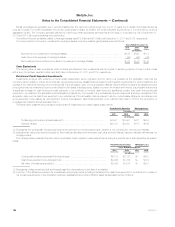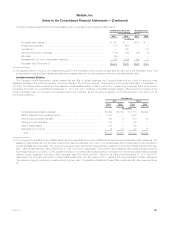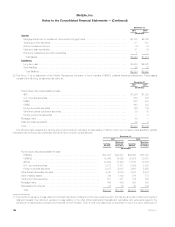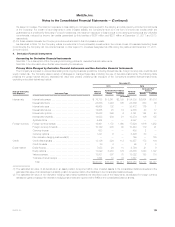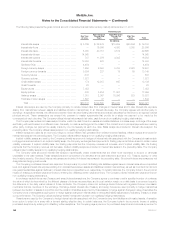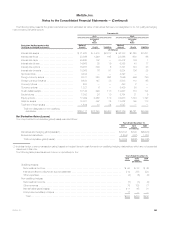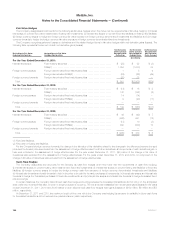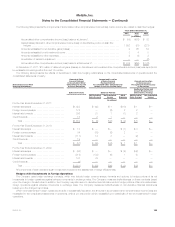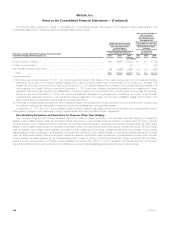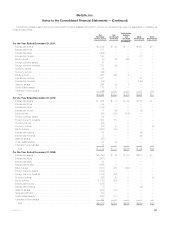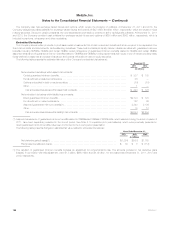MetLife 2011 Annual Report Download - page 144
Download and view the complete annual report
Please find page 144 of the 2011 MetLife annual report below. You can navigate through the pages in the report by either clicking on the pages listed below, or by using the keyword search tool below to find specific information within the annual report.
MetLife, Inc.
Notes to the Consolidated Financial Statements — (Continued)
The following table presents the gross notional amount of derivative financial instruments by maturity at December 31, 2011:
Remaining Life
One Year
or Less
After One Year
Through Five
Years
After Five Years
Through Ten
Years After Ten
Years Total
(In millions)
Interest rate swaps .............................. $ 5,709 $ 26,479 $18,989 $28,556 $ 79,733
Interest rate floors ............................... — 16,866 4,000 3,000 23,866
Interest rate caps ................................ 5,000 40,151 4,514 — 49,665
Interest rate futures .............................. 14,965 — — — 14,965
Interest rate options .............................. 707 11,976 4,305 — 16,988
Interest rate forwards ............................. 13,358 675 — — 14,033
Synthetic GICs ................................. 4,454 — — — 4,454
Foreign currency swaps .......................... 1,255 6,593 5,793 2,820 16,461
Foreign currency forwards ......................... 9,834 237 19 59 10,149
Currency futures ................................ 633 — — — 633
Currency options ................................ 1,321 — — — 1,321
Credit default swaps ............................. 174 12,315 647 — 13,136
Credit forwards ................................. 20 — — — 20
Equity futures ................................... 7,053 — — — 7,053
Equity options .................................. 538 5,254 11,307 — 17,099
Variance swaps ................................. 1,015 2,067 15,396 323 18,801
Total rate of return swaps ......................... 1,597 47 — — 1,644
Total ........................................ $67,633 $122,660 $64,970 $34,758 $290,021
Interest rate swaps are used by the Company primarily to reduce market risks from changes in interest rates and to alter interest rate exposure
arising from mismatches between assets and liabilities (duration mismatches). In an interest rate swap, the Company agrees with another party to
exchange, at specified intervals, the difference between fixed rate and floating rate interest amounts as calculated by reference to an agreed notional
principal amount. These transactions are entered into pursuant to master agreements that provide for a single net payment to be made by the
counterparty at each due date. The Company utilizes interest rate swaps in fair value, cash flow and non-qualifying hedging relationships.
The Company also enters into basis swaps to better match the cash flows from assets and related liabilities. In a basis swap, both legs of the swap
are floating with each based on a different index. Generally, no cash is exchanged at the outset of the contract and no principal payments are made by
either party. A single net payment is usually made by one counterparty at each due date. Basis swaps are included in interest rate swaps in the
preceding table. The Company utilizes basis swaps in non-qualifying hedging relationships.
Inflation swaps are used as an economic hedge to reduce inflation risk generated from inflation-indexed liabilities. Inflation swaps are included in
interest rate swaps in the preceding table. The Company utilizes inflation swaps in non-qualifying hedging relationships.
Implied volatility swaps are used by the Company primarily as economic hedges of interest rate risk associated with the Company’s investments in
mortgage-backed securities. In an implied volatility swap, the Company exchanges fixed payments for floating payments that are linked to certain market
volatility measures. If implied volatility rises, the floating payments that the Company receives will increase, and if implied volatility falls, the floating
payments that the Company receives will decrease. Implied volatility swaps are included in interest rate swaps in the preceding table. The Company
utilizes implied volatility swaps in non-qualifying hedging relationships.
The Company uses structured interest rate swaps to synthetically create investments that are either more expensive to acquire or otherwise
unavailable in the cash markets. These transactions are a combination of a derivative and a cash instrument such as a U.S. Treasury, agency, or other
fixed maturity security. Structured interest rate swaps are included in interest rate swaps in the preceding table. Structured interest rate swaps are not
designated as hedging instruments.
The Company purchases interest rate caps and floors primarily to protect its floating rate liabilities against rises in interest rates above a specified
level, and against interest rate exposure arising from mismatches between assets and liabilities (duration mismatches), as well as to protect its minimum
rate guarantee liabilities against declines in interest rates below a specified level, respectively. In certain instances, the Company locks in the economic
impact of existing purchased caps and floors by entering into offsetting written caps and floors. The Company utilizes interest rate caps and floors in
non-qualifying hedging relationships.
In exchange-traded interest rate (Treasury and swap) futures transactions, the Company agrees to purchase or sell a specified number of contracts,
the value of which is determined by the different classes of interest rate securities, and to post variation margin on a daily basis in an amount equal to
the difference in the daily market values of those contracts. The Company enters into exchange-traded futures with regulated futures commission
merchants that are members of the exchange. Exchange-traded interest rate (Treasury and swap) futures are used primarily to hedge mismatches
between the duration of assets in a portfolio and the duration of liabilities supported by those assets, to hedge against changes in value of securities the
Company owns or anticipates acquiring and to hedge against changes in interest rates on anticipated liability issuances by replicating Treasury or swap
curve performance. The Company utilizes exchange-traded interest rate futures in non-qualifying hedging relationships.
Swaptions are used by the Company to hedge interest rate risk associated with the Company’s long-term liabilities and invested assets. A swaption
is an option to enter into a swap with a forward starting effective date. In certain instances, the Company locks in the economic impact of existing
purchased swaptions by entering into offsetting written swaptions. The Company pays a premium for purchased swaptions and receives a premium for
140 MetLife, Inc.


